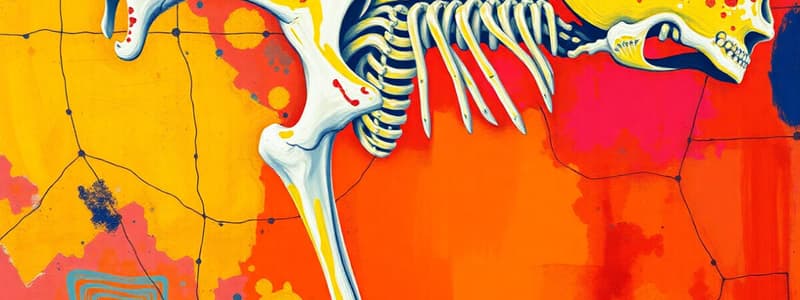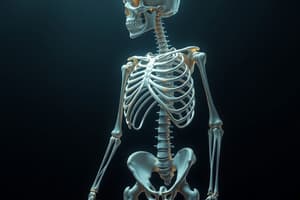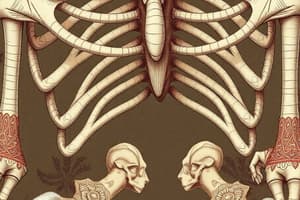Podcast
Questions and Answers
Which process is NOT a function of bone tissue?
Which process is NOT a function of bone tissue?
- Blood formation by bone marrow
- Mechanical support of body parts
- Nerve signal transmission (correct)
- Mineral reservoir
What type of bone provides the structure needed for weight-bearing?
What type of bone provides the structure needed for weight-bearing?
- Cancellous bone
- Compact bone (correct)
- Cartilaginous bone
- Fibrous bone
Which type of fracture is characterized by multiple fragments?
Which type of fracture is characterized by multiple fragments?
- Transverse fracture
- Oblique fracture
- Segmental fracture
- Comminuted fracture (correct)
What primarily causes fracture displacement?
What primarily causes fracture displacement?
Which stage of fracture healing involves the formation of scar tissue?
Which stage of fracture healing involves the formation of scar tissue?
Which of the following fracture types is typically considered incomplete?
Which of the following fracture types is typically considered incomplete?
What is the primary characteristic of a stress fracture?
What is the primary characteristic of a stress fracture?
Which type of bone is found primarily at the ends of long bones and in the vertebrae?
Which type of bone is found primarily at the ends of long bones and in the vertebrae?
Which term describes a fracture where the bone is compressed, often seen in vertebrae?
Which term describes a fracture where the bone is compressed, often seen in vertebrae?
Pain and swelling are commonly associated with which injury?
Pain and swelling are commonly associated with which injury?
What is a critical step to perform when assessing a limb for fracture?
What is a critical step to perform when assessing a limb for fracture?
What is the primary treatment method for a fractured clavicle?
What is the primary treatment method for a fractured clavicle?
Which complication is commonly associated with a supracondylar fracture of the distal humerus?
Which complication is commonly associated with a supracondylar fracture of the distal humerus?
What characterizes a Colles’ fracture?
What characterizes a Colles’ fracture?
Which of the following is a local complication that can occur early after a fracture?
Which of the following is a local complication that can occur early after a fracture?
What is a common cause of a scaphoid fracture?
What is a common cause of a scaphoid fracture?
What general complication may arise from a fracture that involves severe blood loss?
What general complication may arise from a fracture that involves severe blood loss?
What is the typical cause of a fracture of the neck of the femur?
What is the typical cause of a fracture of the neck of the femur?
What type of treatment method is indicated for closed reduction of a fracture?
What type of treatment method is indicated for closed reduction of a fracture?
Which of the following signs is associated with a fracture shaft of the humerus?
Which of the following signs is associated with a fracture shaft of the humerus?
Flashcards
Bone Function: Mechanical
Bone Function: Mechanical
Bone provides support, protection for organs, allows movement, and enables body growth.
Bone Function: Biochemical
Bone Function: Biochemical
Bones store minerals, maintain ion balance, and contribute to blood cell production in the marrow.
Cortical Bone
Cortical Bone
Dense bone found in the outer layer of bones, shaft of long bones, and joint surfaces. It provides strength and support.
Cancellous Bone
Cancellous Bone
Signup and view all the flashcards
Fracture Definition
Fracture Definition
Signup and view all the flashcards
Fracture Mechanism: Direct Force
Fracture Mechanism: Direct Force
Signup and view all the flashcards
Fracture Mechanism: Indirect Force
Fracture Mechanism: Indirect Force
Signup and view all the flashcards
Incomplete Fracture
Incomplete Fracture
Signup and view all the flashcards
Complete Fracture
Complete Fracture
Signup and view all the flashcards
Fracture Displacement: Shift
Fracture Displacement: Shift
Signup and view all the flashcards
Fracture Assessment: Look
Fracture Assessment: Look
Signup and view all the flashcards
Fracture Assessment: Feel
Fracture Assessment: Feel
Signup and view all the flashcards
Fracture Assessment: Move
Fracture Assessment: Move
Signup and view all the flashcards
General Treatment of Fracture
General Treatment of Fracture
Signup and view all the flashcards
Local Treatment of Fracture
Local Treatment of Fracture
Signup and view all the flashcards
Compartment Syndrome
Compartment Syndrome
Signup and view all the flashcards
Avascular Necrosis
Avascular Necrosis
Signup and view all the flashcards
Clavicle Fracture
Clavicle Fracture
Signup and view all the flashcards
Fracture Shaft of Humerus
Fracture Shaft of Humerus
Signup and view all the flashcards
Colles' Fracture
Colles' Fracture
Signup and view all the flashcards
Study Notes
Bone Structure and Function
- Bone is a specialized connective tissue acting as the endoskeleton
- Mechanical Functions:
- Enables longitudinal growth of the body and extremities
- Supports body parts
- Protects vital soft tissues
- Forms levers for muscle action and movement
- Biochemical Functions:
- Stores minerals
- Maintains homeostasis of certain ions
- Blood Formation:
- Site of erythropoiesis (red blood cell production) in the bone marrow
Types of Bones
- Cortical (Compact) Bone:
- Dense bone, providing support where needed
- Forms the outer layer of all bones
- Forms the shaft of tubular bones
- Found on articular surfaces of bone ends
- Cancellous (Spongy, Trabecular) Bone:
- Forms the inner meshwork of all bones
- Found at the ends of tubular bones
- Found within the vertebral bodies
Fractures: Definition and Mechanisms
- A fracture is a break in the structural continuity of a bone.
- Mechanisms of Injury:
- Direct force: A force applied directly to the bone
- Indirect force: A force applied elsewhere on the body
- Combined force: A combination of direct and indirect forces
- Types of Force:
- Single strong force: Causes classical fractures
- Repeated minor force: Causes stress fractures
- Normal force of daily activities: May cause pathological fractures
Types of Fractures (Incomplete)
- Crack: A small break in the bone
- Buckle fracture: Bone bends and the cortex buckles
- Greenstick fracture: Partially broken bone, common in children
- Compression (impacted) fracture: Bone is compressed
Types of Fractures (Complete)
- 2-fragment fracture: Bone breaks into two pieces
- Transverse fracture: Break is at a right angle to the bone's long axis
- Oblique fracture: Break at an angle to the bone's long axis
- Spiral fracture: Break wraps around the bone's long axis
- 3 or more fragment fracture: Bone breaks into 3 or more pieces, including butterfly, segmental, and comminuted fractures
Fracture Displacement
- Causes:
- Same injury mechanism
- Gravity
- Pulling of attached muscles
- Types:
- Shift (translation)
- Tilt (angulation)
- Twist (rotation)
- Length (shortening/lengthening)
Fracture Healing Stages
- Hematoma formation: Blood clot forms at the fracture site
- Inflammation and granulation tissue formation: The body prepares for healing
- Callus formation: Cartilage and bone form a bridge across the fracture
- Consolidation: The callus is replaced by bone.
- Remodeling: Bone is reshaped and strengthened over time
Clinical Features of Fractures
- History (symptoms): Pain, swelling, deformity, limitation of movement, loss of function, and bruising
- Examination (signs): Look for swelling, deformity, bruising, wounds. Feel for tenderness and crepitation. Move the limb appropriately. Check neurovascular status distally
Investigations
- X-ray: Visualizes fractures
- CT scan: Detailed view of fractures, and surrounding soft tissue
Fracture Treatment
- General Treatment: Analgesia, fluid replacement, antibiotics
- Local Treatment: Reduction (closed or open), hold reduction (e.g., splint, traction, internal fixations, external fixations), exercises, and elevation
Fracture Complications
- General Complications: Hypovolemia, shock, DVT, PE, bedsores, UTI, and disuse atrophy
- Early Complications: Vascular injury, nerve injury, visceral injury, compartment syndrome, hemarthrosis, infection, fracture blisters, pressure sores
- Late Complications: Delayed union, nonunion, malunion, avascular necrosis, joint stiffness, heterotopic ossification, growth disturbances, nerve entrapment, reflex sympathetic dystrophy, osteoarthritis
Common Fractures (Upper Limb)
- Clavicle Fracture: Direct or indirect trauma, pain and swelling, medial/lateral segment displacement. Treatment: sling.
- Humerus Shaft Fracture: Direct trauma, pain, swelling, deformity, potential radial nerve injury. Treatment: surgery.
- Supracondylar Fracture of Distal Humerus: Indirect trauma, possible brachial artery injury. Treatment: surgery.
- Colles' Fracture: Fall on the hand, pain, swelling, dinner fork deformity, potential median nerve injury. Treatment: manipulation and cast splint.
- Scaphoid Fracture: Fall on the hand, pain, swelling, anatomical snuff box tenderness, potential avascular necrosis.
Common Fractures (Lower Limb)
- Neck of Femur Fracture: Indirect trauma, pain, inability to ambulate, potential avascular necrosis. Treatment: surgery
- Shaft of Femur Fracture: Direct or indirect trauma, pain, swelling, loss of function, risk of bleeding. Treatment: surgery.
- Supracondylar Fracture of Distal Femur: Indirect trauma, risk of popliteal artery injury. Treatment: surgery
- Proximal Fibula Fracture: Risk of common peroneal nerve injury, possible foot drop.
- Shaft of Tibia Fracture: Risk of overlying skin break with contamination (compound fracture).
- Calcaneus Fracture: Fall from height, possible pelvic and spinal fractures, chronic heel pain due to joint distortion.
Studying That Suits You
Use AI to generate personalized quizzes and flashcards to suit your learning preferences.




